 |
Science and Technology Review Gives Lab High Marks |
 |
Safety glasses save eyesight in soldering incident |
 |
Introducing Mike Dallas |
 |
Exploiting the human element: Cyber Security social engineering |
 |
Check out JLab's main webpage story |
 |
In Their Own Words - Alex Dzierba |
 |
Summer Student Enjoys REU Experience |
 |
Summer Science Enrichment Programs achieve resounding success |
 |
BigBite is Reborn |
 |
Rachel Black receives National Science Foundation Fellowship |
 |
Walt Akers wins national DAR award |
Science and Technology Review Gives Lab High Marks(top ^)
Jefferson Lab's scientific program was described as "very impressive despite funding issues" during the recent Science and Technology Review.
The Department of Energy (DOE) conducted its annual S&T Review of the Lab July 12-14. The review evaluates the quality, performance and significance of Jefferson Lab's major activities in the context of the national nuclear physics program put forth by the Nuclear Science Advisory Committee's (NSAC) and the Department of Energy's long-range plans.
The review committee included senior DOE managers, senior staff from other DOE labs and scientific experts in hadronic and high- energy physics and related fields of research. This year's team was chaired by Brad Tippens, DOE Program Manager for Medium Energy Nuclear Physics for the Office of Science, Office of Nuclear Physics; Roy Holt, Argonne National Lab; John Kogut, DOE Office of Science, Office of High Energy Physics; Gerald Miller, University of Washington; Shigemi Ohta, Institute of Particle and Nuclear Studies, The High Energy Accelerator Organization (KEK); Ilan Ben-Zvi, Brookhaven National Lab; Ferdinand Willeke, Deutsches Elektronen-Synchrotron; and John Cumalat, University of Colorado at Boulder.
The two days of presentations were, at times, simultaneous and the reviewers heard a wide range of briefings from Lab management and its scientific staff, including a short welcome from Jefferson Science Associates, LLC (JSA) Board Member and President of the Southeastern Universities Research Association, Jerry Draayer. The panel talks included the current nuclear physics program and its upcoming experiments as well as future experiments after the 12 GeV Upgrade is complete; accelerator operations, research and development including the Free-Electron Laser (FEL) and International Linear Collider (ILC) activities; and Lattice Quantum Chromodynamics (QCD) achievements and future plans.
A closeout meeting commended Lab management and scientific staff in many areas. The review committee members were impressed with the continued development of innovative shields and detectors that allow experiments to run at higher and higher energies. The members acknowledged that the just announced HAPPEx data halved the errors of the previous world data. The review committee commented that the 12 GeV program provides an opportunity to revolutionize our knowledge of the distribution of charge and current in the nucleon and to explore QCD in the non-perturbative regime by searching for and identifying exotic mesons, by performing precision tests of the Standard Model and by studying quark propagation through nuclear matter.
The review committee members stated that the theoretical efforts by Lab staff seem well-integrated with the experimental efforts. The members also stated that the Excited Baryon Analysis Center (EBAC) established in 2006 promises to have an impact on the Lab's experimental program by relating measurements of cross-sections to properties of baryons. This effort could aid in the ultimate goal of discovering new states of matter. The committee members found that the Lattice QCD (LQCD) program calculations are beginning to achieve relevant results for nuclear physics that could ultimately provide a detailed understanding of nuclear structure based on QCD. They observed the synergy among the LQCD group, theorists and experimentalists and stated that the research atmosphere at the Lab is benefiting from the close cooperation between theory and experiment as well as the enthusiasm of the LQCD group.
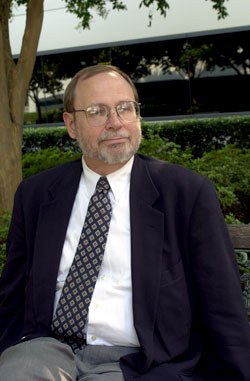
Dennis Kovar
The review committee members complimented the Lab on achieving an unprecedented beam polarization of 85% and the demonstrated capability to conduct parity violation experiments and three-hall operations. The members extended congratulations for well-trained, highly motivated operations staff members who contend with high demands while delivering excellent operations. They congratulated the cryogenics group for optimizing Lab cryogenic operations with an overall reduction in energy consumption of 20 percent, resulting in a substantial cost savings and with benefit to the entire cryogenic-based accelerator community. The Jefferson Lab Center for the Advanced Studies of Accelerators (CASA) was recognized as contributing to performance improvement in accelerator operations and for training young accelerator physicists. The Lab's accelerator research and development program is deemed unique with world-class expertise in SRF, polarized beams and energy-recovering linacs, as well as high-power FELs.
The review committee members complimented Lab staff on being leaders in their fields, serving on high-level committees and contributing in meetings. Committee members were impressed with the publication record of the staff and found that record to be indicative of the Lab's productivity. The User community was complemented on their activist role in support of the Lab's interests and the committee mentioned the community's quick political action in response to the FY2007 budget.
Dennis Kovar, Office of Science Associate Director of Nuclear Physics, wrapped up the meeting by remarking that securing the 12 GeV Upgrade's Critical Decision-1 was "essential and a first step." "The Lab's management should be complimented on its handling of the tough FY2006 funding year and its anticipation of that funding decline in FY2005." Kovar was impressed with the experimental program as well as the cryoplant improvements. Kovar said, "he walks away with a good impression of the accelerator staff, the high-quality experimental program and the very motivated staff," and noted that the goals of the Jefferson Science Associates, LLC were well founded, and he wished the new JLab/JSA team well. In closing, Kovar remarked that, "the Lab has much to be proud of."
The review is an important part of Jefferson Lab's performance-based contract. Metrics from each DOE review are tracked, measured and reported. At the end of each year, DOE rates the Lab, based on the combined results of Lab self-assessments, review results and DOE appraisals. Areas of responsibility rated during this S&T review included experimental research; theory; accelerator operations; work for others (FEL); staff and User community; the environment health and safety program; and institutional management.
Safety glasses save eyesight in soldering incident(top ^)
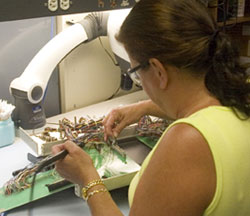
Repairing over 300 radio frequency backplanes requires hours of soldering per board while wearing safety glasses.
Just a simple pair of safety glasses can save your eyesight as Michelle Brisiel recently found out while soldering. As an electronics technician for the Electrical Engineering Support Services group, Michelle works as part of a team that solders electronic components here at the Lab. That group has been working on a big re-soldering job for a year now, replacing boards on every radio frequency backplane that is used in the accelerator which requires many hours of soldering. Michelle sometimes wondered if the required use of safety glasses was really necessary she had never encountered an incident during her 12 years of soldering on the job that seemed to justify the need to wear them--until now. Michelle was busy with her re-soldering job when a simple solder connection to a wire did not quite hold and allowed the wire to spring back out of position, flinging the hot solder directly toward Michelle's right eye. Lucky for her, she was wearing her safety glasses. That spot of solder melted onto her safety glasses instead of her eye and in her words, " I am glad to be wearing safety glasses. I am glad it is a safety policy to wear safety glasses while soldering. I didn't always agree with this policy but now I see the need [for the policy] and best of all, I can still see!".
Introducing Mike Dallas(top ^)
The Lab's new Chief Operating Officer, Mike Dallas, has had a long and distinguished career, first in the U.S. Army, where he served in a variety of staff and command positions, leading men and women in conflicts around the globe, and then with Computer Sciences Corporation (CSC), where, in his most recent job, he served as the General Manager, Center Operations Support Services, at the Johnson Space Center in Houston, Texas.
Both his military and corporate backgrounds, he believes, have prepared him well for his current position, which came about as a result of the recently signed agreement with Jefferson Science Associates (JSA) - a collaboration between SURA and CSC -- which assumed operational control of Jefferson Lab under the new management and operating contract with the Department of Energy.
"There are differences here, of course," he says of working in a world of science, "but not from the standpoint of leading people. It's a different environment, a different product, but the goal is the same - to create a successful result. "
Since his arrival in December, he's made a sustained effort to get out and meet the people at the Lab, probing their needs and motivations.
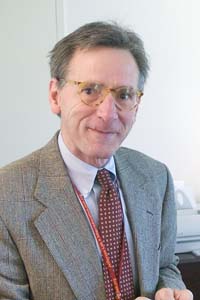
Mike Dallas
"I believe my job is to help the Lab achieve it mission of discovery caliber science with the resources we have available. My job is to streamline our business processes to enable the world-class experiments we do here.
Dallas readily acknowledges that as a leader in the military and the corporate world, he was accustomed to getting inputs and opinions, then making a decision and moving on. The highly collaborative nature of the culture at the Lab has already taught him to be more patient.
"I hope I am learning to listen better," "I know that I have a tendency to move quickly," he says. "I've learned that just because something worked in another organization, it's not necessarily going to work here at Jefferson Lab. That's one of the many interesting aspects of Jefferson Lab's culture - the highly collaborative nature of decision making. "
Dallas is not surprised to find brilliant physicists here, he says, but he is awed at the depth of their interests.
"These are truly Renaissance men and women. They're not only brilliant scientists and engineers but are accomplished artists and musicians," he says.
Dallas holds a Bachelor's in Business Administration and Master's in Human Resource Management; he also completed a fellowship program in Strategic Planning at the Sloan School, MIT, and is a Certified Project Manager.
His education had been put on hold when he originally went to college. Lured by his true first love, Dallas set out as a drummer with rock and roll and rhythm and blues bands, touring the Midwest and contemplating a career in music. Being drafted into the Vietnam War in 1966 changed the course of his life, but that drummer is still in his heart.
If you look carefully, you'll see a set of drumsticks on the desk in his office.
"I still have all the licks in my head," Dallas says with a smile.
Exploiting the human element: Cyber Security social engineering(top ^)
The term "social engineering" seems like something you might read about in a political science or psychology book, when in fact, it is the most common method currently being used by computer hackers to access information and systems that they have no right to. Social engineering focuses on the weakest link of the cyber security chain - humans - to circumvent the policies, procedures and hardware safeguards in place to keep hackers out. The security of both the Lab's systems and your personal computer depends on each of us being aware of social engineering techniques and avoiding actions that will allow an intruder access to Lab systems and information.
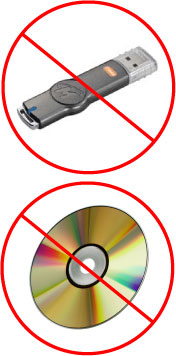
Never accept and use a memory stick from an unknown person or source. Be wary of inserting CDs into your computer from an unknown source.
Social engineering, as a non-technical kind of intrusion, relies heavily on human interaction and often involves tricking other people to break normal security procedures.
Many of us may have already been the target of social engineering attacks, including "phishing," a common form of social engineering where the hacker sends official-looking emails to obtain account or other sensitive information. Other techniques used to circumvent security procedures include: posing as a legitimate staff member or user with an urgent request for an account number, password, PIN, etc. and "planting" of seemingly desirable items such as memory sticks or CDs that when attached to your computer, acts as a gateway to your system. These types of attacks are being used daily to access personal information and to gain system access, and the impacts can be very serious on our staff and users as well as on JLab's ability to deliver top-quality scientific programs.
Here are some tips to help thwart social engineering attacks:
Be sure that you always follow JLab cyber security policies and procedures (They protect you and the Lab).
Do not open any email attachments that are suspicious (unknown sender, unexpected email with an attachment or asking for information, etc. ).
Don't use a CD or memory stick from an unknown source. For example, one DOE lab was successfully attacked when a staff member inserted an official-looking CD into a computer that arrived in the mail claiming it was a compilation of new DOE policies, and yes the policies were actually there ... along with a computer virus).
And yes, that urgent call at 4:45 pm on a Friday afternoon from someone you do not know claiming to be from the cyber security staff and asking for your password...guess what... social engineering.
When in doubt, throw it out! E-mails, electronic media or other requests that you are suspicious of are just not worth the risk. You could be jeopardizing the Lab and your own personal information as well.
Check out JLab's main webpage story(top ^)

Hyperon
While a regular nucleus is built of just protons and neutrons, a hypernucleus contains at least one extra particle: a hyperon. Researchers created hypernuclei in experiments in Halls A and C to study the deep interior of the nucleus and provide new insights into the structure of matter.
The results may also give scientists a rare glimpse into the structure of neutron stars, where hyperons are thought to play a major role. To get the full story, visit: http://www.jlab.org/.
In Their Own Words - Alex Dzierba(top ^)
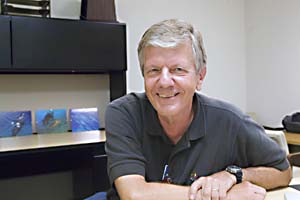
Alex Dzierba
I was born and raised in Buffalo, N.Y. , and I vowed early that I'd never live in a climate like that again if I could help it. As the oldest boy in a Polish Catholic family, it seemed as if I would follow my mother's wishes and become a priest. I went to Catholic elementary school and then a four-year high school/seminary. After I went on my first date, I decided the priesthood was probably not my calling, and I chose the most radically different path I could think of: physics.
After graduating from a Jesuit school, Carnisius College, I went to Notre Dame for my graduate work. I'd originally thought of becoming a particle theorist - not that far, I thought, from being a priest - but decided instead to become an experimentalist.
After I received my PhD in 1969, I had a four-year post-doc at Cal Tech, working with Alvin Tollestrup's experimental group. We would all regularly meet with the CalTech theorists, Richard Feynman, Murray Gell-Mann, George Zweig and others. This was all like a dream come true for me. I thought I really knew physics until I got there.
In 1973, I was offered a position teaching at Indiana University at Bloomington, and I've done that ever since. I loved teaching. I developed an Honors Introductory Course in physics there, and I'm currently working on a textbook for just such a course.
During the course of my career, I've served as a program officer at the National Science Foundation from 1982 to 1983 and was a scientific associate at CERN from 1985 to 1986. My path to the Jefferson Lab actually started when I was working collaboratively with colleagues at Cal Tech on two experiments at the Fermi Lab, both of which I was the scientific spokesman for. One was an early bubble chamber experiment to look at the interaction of high-energy protons, and the other was similar but used an electronic version of the bubble chamber, which was an early precursor of our current GlueX work.
By the early 1990's, I was the chairman of the users' group at Brookhaven and that's when I met Nathan Isgur, who encouraged me to come to do experiments here. He heard me speak at a users meeting at Brookhaven and asked me to give a talk here on meson spectrometry. At that point, our group from Indiana moved our focus to Newport News.
In 1997, we held a workshop at Indiana to put together the ultimate experiment to search for exotic meson and the result of that workshop is GlueX. Since we will need the 12 GeV upgrade, my position here at the Lab now is to work with the Director and his staff on that project and the creation of Hall D.
In 2004, I was asked to give a Distinguished Faculty lecture at Indiana, which may well have the best music school in the country. Don Freund, a music professor, was in the audience for my talk and, intrigued by the topic, he wrote a piece called "Exotic Particles and the Confinement of Quarks - A Subatomic Fantasy for Wind Ensemble. " So I think I'm the only physicist in the world with music written for his experiment.
I've been married for a little more than 20 years to my wife, Linda, who is in real estate. I have grown children from my first marriage, and a 16-year-old son with Linda. I believe strongly in outreach, so I've done science demos at my son's elementary school and taught a course on special relativity at his high school. Here at the Lab, I've been involved with TAPS and I counsel the SULI students on the GREs, for which I serve on the Board of Examiners in physics.
We've recently taken up SCUBA diving as a family, a wonderful enhancement to our existing hobby of photography. We live 15 miles south of Bloomington on a 16-acre farm that we share with several horses; we built all our outbuildings together, including the one in which I do my woodworking.
Summer Student Enjoys REU Experience(top ^)
Jefferson Lab welcomes a number of students into the research setting each summer through various programs, funded by both the Lab and outside sources. The National Science Foundation sponsors Research Experiences for Undergraduates (REU), at nearly 700 research sites throughout the United States. Colleges across the US apply to be a REU site each year. The College of William and Mary has consistently been awarded this opportunity.
During their first week at a host school, students are introduced to research facilities in the surrounding areas. Jefferson Lab has hosted REU students since the beginning of its operation. The participating facilities present a variety of summer research opportunities, from which the undergraduate students are given the chance to choose a project they are interested in being involved with.
"It's not like 'Here, eat this. It's like go in that candy store and take your pick. 'It's fantastic," FEL Basic Research Program Manager and REU mentor Gwyn Williams explained.
Williams, who has been a REU mentor since he came to the lab six years ago, thinks the REU program's way of incorporating students into research is key. The idea that students get to choose a project, rather than be forced into working on something they may not interested in makes for more enthusiastic interns.
Megan Ivory, a senior at St. Vincent's College in Pennsylvania, is one of the five REU students who shares an enthusiasm for physics at Jefferson Lab.

When outside the research setting, REU students were given the chance to explore the recreation Virginia has to offer. Here Megan Ivory is kayaking on the Poquoson River.
Working in the FEL Building under the direction of Williams, Ivory's focus for the summer is on the terahertz project. Williams' presentation of the project fascinated Ivory, who had never heard of terahertz in the electromagnetic spectrum. She was interested in the concept and potential applications of this relatively new area of physics, and chose to work with Williams for the summer.
Ivory relied on Williams' dedication and enthusiasm to guide her learning experience at the Lab. "Your mentor and other members of the team don't expect you to know that much about the field, but they do expect you to learn about it," Ivory explained.
Williams agreed that the program can be rigorous, but that the students are up to the challenge.
"I think we drive them pretty hard, but they are very good students, and they just enjoy the experience," he said.
Nearing the end of the program, Ivory was able to talk extensively and enthusiastically about her work at the lab this summer.
"The FEL building has the world's most powerful broadband source of terahertz, but they don't know how powerful it is exactly, so it's my job to measure the absolute power of it," she explained. "Because terahertz is such a new area of the spectrum, the team didn't know if the power meter could be trusted. The majority of my project has been characterizing the power meter to make sure it actually does work," she continued. "My research is actually helping out the whole team-it's very exciting."
Many student interns at the lab are assigned to projects that do indeed advance research efforts. In fact, Williams points out that the benefits of the program are two-fold.
"They do things we don't have time to measure, often filling in details that are really important, that we would normally not have the luxury of being able to do," he explained.
The contributions students make to the Lab are just one of the rewards of the program. "Research experience through the REU program reinforces a student's interest in research, teaches them safety early in their scientific careers, and gives them confidence," remarked Williams.
Ivory recalls second-guessing her major for the first three years of her undergraduate career. Her experience here gave her a new perspective. "I've been able to see all the different possibilities for a physics major, and all the different things people do with it," she remarked. "I think a big part of getting excited about physics is being around people who are also very excited about it. "
"As mentors, we aim to send students away loving and living the excitement of science and discovery," Williams said. "That's what you can give them-everything else they can read in a book".
Summer Science Enrichment Programs achieve resounding success(top ^)
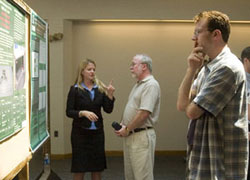
Old Dominion University junior Rachel Sparks, a summer SULI participant, presents her poster.
The CEBAF Center lobby was abuzz with activity in early August as the 39 participants in the Lab's summer science education programs showed off their posters and discussed their projects with fellow participants, Lab users and staffers and even proud parents.
High school students participated in the Lab's summer honors program (HSSHP), and college students preparing for careers in science and engineering participated in the Science Undergraduate Laboratory Internship (SULI) program. Middle-school teachers took part in the Teacher Academy in Physical Science (TAPS) experience.
SULI participant Ian Howley, who's going into his junior year at The College of William & Mary, said the program gave him the opportunity to make the leap from textbooks to real-world physics.
"This was really eye-opening for me towards a career in physics," he said enthusiastically. "Just to be able to come to the Lab and see the process and how it's all really done has been wonderful. "
Ian credits a really terrific teacher he had in his senior year of high school on Long Island with stirring his interest in pursuing physics. He has an eye on astrophysics, but admits he's been told that it's a very difficult field. "Particle physics is a close second," he said, "as what I'll pursue. "
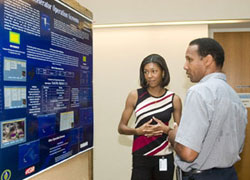
Hampton High school senior, Christina Chapman, participated in the high school program and plans a science career.
Christina Chapman, who's going to be a senior at Hampton High School this year, said this was the best science summer program she's attended, and she has some good comparisons. When she was going into the 9th grade she was tapped to take part in the Hampton University's Young Doctors' Program.
"I learned a lot here," she said, extolling the program. "I never thought I'd get to this point. I feel really important. " She hopes to pursue a career in material science engineering and will be applying to Virginia Tech, the University of Maryland and North Carolina State University.
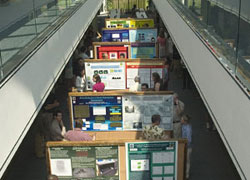
A total of 41 posters were prepared for the end of summer presentation of Lab posters by high school and college students as well as middle school math and science teachers.
At least one of the participants was a happy returnee to the Lab's summer program for teachers. Ray Yoh, an 8th grade physical science teacher at Peasley Middle School in Gloucester, was back for his fourth summer. He took part in the program that preceded the current TAPS program, which is limited to three years of attendance. "I'm hoping they'll come up with something new next year so I can come back again," he said with a laugh. "This is a real pump of adrenaline to be surrounded by new ideas, and these people really go out of their way to help and even stay in touch. "
His experiences at the Lab have paid off handsomely for his students. A group of his young women students won the regional leg of an on-line science competition last year, which included a $2,000 savings bond for each one, and another group of students placed first in JLab's Middle School Science Bowl, winning them an expense-paid trip to Denver to compete in the National Science Bowl.
Jan Tyler, Jlab's Science Education program manager, praised not only the students and their accomplishments but everyone who helped make the programs a success.
"My thanks go out to the lab staff and users who make these programs possible and help train teachers and students in real-world science," she said.
BigBite is Reborn(top ^)
At Jefferson Lab's recent Users Meeting, DOE's Dennis Kovar and NSF's Brad Keister emphasized the funding agencies' commitment to pursuing a cohesive nuclear physics research program in the United States. For instance, Jefferson Lab is funded by DOE; however, NSF provides for many of the Lab's Users and students and some of the instrumentation used in experiments, such as the recently upgraded BigBite spectrometer.
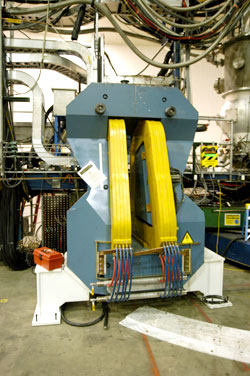
The BigBite magnet during installation in Hall A.
BigBite was originally used at NIKHEF, the National Institute for Nuclear Physics and High Energy Physics in the Netherlands. After the experimental area it was installed in closed, Hall A Leader Kees de Jager envisioned a productive future for BigBite at Jefferson Lab. He brought BigBite to the Lab in 1999 to enhance Hall A's research capabilities. However, since the spectrometer was designed for use at NIKHEF, the researchers had to refurbish it before it could be used here.
A group of University of Virginia (UVA) researchers applied for a National Science Foundation (NSF) Major Research Instrumentation (MRI) grant in 2002. NSF's MRI Program is designed to increase access to scientific and engineering equipment for research and research training in our Nation's organizations of higher education, research museums and non-profit research organizations.
Richard Lindgren, a UVA research professor and MRI principal investigator, explains that the researchers also acquired additional funding. "At that time, in order to get an MRI, you needed to have at least 30% matching funding from other facilities. And they could not be DOE-funded laboratories. So we had partners, such as the University of Glasgow and Tel Aviv, and they put up money to build part of the detector system," he says.
In October 2002, the team was awarded an MRI grant for $441,000 to upgrade BigBite. "The total amount of money of putting this package together is on the order of a million dollars, if you count everything," Lindgren says. The upgrade plan was crafted by Lindgren and Bogdan Wojtsekhowski, a Hall A Staff Scientist and a spokesperson for the neutron electric form factor experiment (GEn).
The MRI collaboration worked hard for over three years fine-tuning the design and constructing the new instrumentation for BigBite. The NSF funds were used to build a universal scattering chamber with a very large vertical opening to match BigBite's large acceptance and three Multi-Wire Drift Chambers (MWDC) with 15 planes and 2654 signal wires to provide a position resolution of 0.2 millimeters.
MRI Co-Principle Investigator and UVA Assistant Professor Nilanga Liyanage led a group of students from the Department of Physics at UVA in developing new infrastructure and completing the construction of the high-quality drift chambers. "This was an especially nice project for the undergraduates, because the physics was within their grasp; it was a nice match to the undergraduate curriculum," he says.
In all, Liyanage oversaw ten students, including two Ph.D. students and one Master's student. "I had two Ph.D. students, Brandon Craver and Mitra Shabestari. Also, I got a lot of help from UVA Research Associate Vladimir Nelyubin on this project," he says, "Basically, Vladimir and the students put [the BigBite wire chambers] together. "
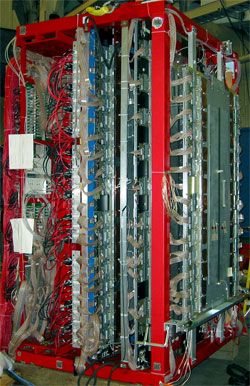
A side view of BigBite's new detector package, including the multiwire drift chambers awaiting testing before being mounted in Big Bite.
Lindgren notes that the preliminary plans for BigBite changed as the refurbishment progressed, "Initially we were going to build what are called proportional chambers. But as time went on, it was learned that [at least one of the experiments] was going to require more accurate measurements of the angles of the electrons scattered from the target. And in order to do that, we had to change the design from a proportional chamber to a drift chamber, which allows you to measure the particle angles more accurately. "
With the upgrade complete, BigBite is an essential tool for experiments that require large angular and momentum acceptances, and the upgraded spectrometer complements Hall A's smaller-acceptance High Resolution Spectrometers (HRS). "BigBite offers something that the High Resolution Spectrometers do not, and that's large acceptance," Lindgren comments. In addition, the new rate capability of the upgraded BigBite detector achieves the maximum luminosity obtained with polarized targets.
Dennis Kovar is the DOE Associate Director of the Office of Science's Office of Nuclear Physics, and Brad Keister is a Program Director in the NSF Directorate for Mathematical & Physical Sciences in the Division of Physics.
BigBite has been used in two Hall A experiments thus far. One was the short-range correlation experiment, which ran in the spring of 2005 (see the full story) and the other, which required the fully upgraded BigBite, was the neutron electric form factor experiment (GEn) completed in May 2006. GEn was the first test of the newly constructed wire chambers.
The spectrometer improved the typical Hall A count rate for polarized target experiments by a factor of 50, and the new detector package is allowing BigBite to operate at a luminosity that's 10,000 times higher than its limit at NIKHEF. "So a typical spectrometer wire chamber sees a couple of million particles per second. With BigBite, we see 20 million particles per second," Liyanage explains.
In addition to its recent successes, Wojtsekhowski also sees a bright future for BigBite. "The large acceptance and high luminosity features of BigBite have a great potential for future experiments at JLab, including experiments that will be proposed for the 12 GeV Upgrade," he says.
Hall A experiments scheduled to take advantage of BigBite's unique features account for 100 days of total approved beam time and include one of the original experiments put forth for upgrading BigBite, the electroproduction of pions at threshold experiment, E04-007. Other experiments which propose to use BigBite are: E05-009, E05-015, E06-010, E06-011, and E06-014.
Rachel Black receives National Science Foundation Fellowship(top ^)
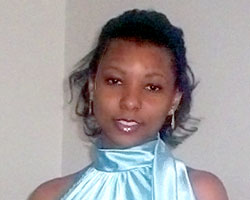
Rachel Black
Hampton University graduate student Rachel Black has received a National Science Foundation (NSF) three-year Fellowship, based on her work at the Jefferson Lab. The fellowship will pay for her tuition and other school costs, as well as $30,000-a-year stipend and travel expenses.
A native of Baltimore, Maryland, whose mom encouraged her to participate in many outside activities involving math and science, Black graduated from Morgan State University with a degree in Engineering Physics. She started her graduate work at Jackson State University and then transferred last year to Hampton University (HU) into a program she found more challenging.
During the summer of 2004, she was chosen to work in the Science Undergraduate Laboratory Internship (SULI) as a student in the Detector and Imaging Group here at Jefferson Lab, working with Group Leader Stan Majewski.
"I had already decided I wanted to pursue medical physics," she recalled, "and was thrilled to get work on projects with Stan. "
Majewski had high praise for Black's work and dedication. "I have not dealt with a more enthusiastic, dedicated and bright -- all in one! -- student in a long time," he noted. "She strives to succeed against many obstacles. I am very happy to learn about her NSF fellowship and I am absolutely sure that she will succeed in her professional career. "
She also worked with Ben Welsh. Her research advisor at HU is Professor Paul Guèye. She credits Dr. Cynthia Keppel at HU with encouraging her to apply for outside fellowships and Guèye for encouraging her to apply for the NSF Fellowship.
"I was flabbergasted when I got the email that I'd gotten the fellowship," she said with a laugh. The message arrived on March 31 of this year, too close to April Fool's Day for her to believe it was real. "I didn't tell anyone. I went to the grocery store. I went to sleep. I woke up the next morning and it was still there!"
Her work at the Lab in Brachytherapy (an outpatient treatment modality using tiny radioactive sources inserted via catheters inside or near cancer tumors) and searching for a modified, more tumor targeted source has particular meaning for Rachel, since she has lost several relatives to cancer.
"It's fulfilling to think that the work I'm doing might help somebody someday," she said. "I would rather my work end up in the real world, than in a textbook. "
Walt Akers wins national DAR award (top ^)
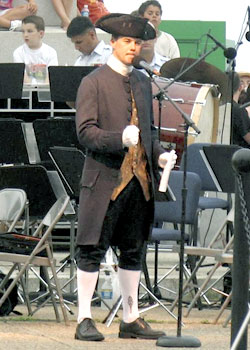
Walt Akers in full Fifes and Drum costume reciting the Declaration of Independence at a recent July 4th Yorktown, Virginia celebration.
The Jefferson Lab's Infrastructure Manager, Walt Akers, recently received a national award for his community service from the Daughters of the American Revolution (DAR). The award was given for his work with the funding and construction of a new 4,000-square-foot building for the Fifes and Drums of York Town (cq).
The Corps was formed in 1976 by York County during the Bicentennial of the American Revolution and it has grown over the past seven years, under Akers' leadership, from 30 members to 72 today. Boys and girls between the ages of 10 and 18 comprise the Corps, which puts on about 120 shows each year. When they've reached senior status, according to their abilities, they may participate in parades and wear the Regimental uniforms reminiscent of the 18th century musicians who served in the Continental Army in Yorktown, Virginia.
Walt first became involved with the group when his daughter became a member, and then he shouldered the responsibility for leadership after the previous president stepped down. He led the process of securing land from the National Parks Service and then walking the proposal for the new building step by step through the process to completion.
"We had to go through seven levels of approval before we could even begin to build," he noted.
The $300,000 construction cost was raised from donations - of which the DAR initially contributed $20,000 and recently an additional $15,000 - and Akers acted as the general contractor for the job in order to save money.
"Basically, we've got a building that would have cost us $650,000," he said.
Now, the Fifes and Drums have plenty of room to practice and ready themselves for upcoming appearances in Boston and at the 225th anniversary of the British surrender at Yorktown in October, as well as in next year's celebrations at Jamestown.
Walt's award came after his application, which was supported by Rep. Joanne Davis and Dan Smith, the Superintendent of Colonial National Historic Park, made its way up through local and regional competitions, in which he took first place. At the national level, he placed third, behind the Director of the USO and the Director of a home for disabled veterans.
Walt credits his wife, Evelyn, who is the Lab's Help Desk Administrator, with taking care of their home and family while he puts in his 1,200 hours of volunteer service a year. "The Lab has also been very supportive and patient, especially when we have performances out of town," he added.

